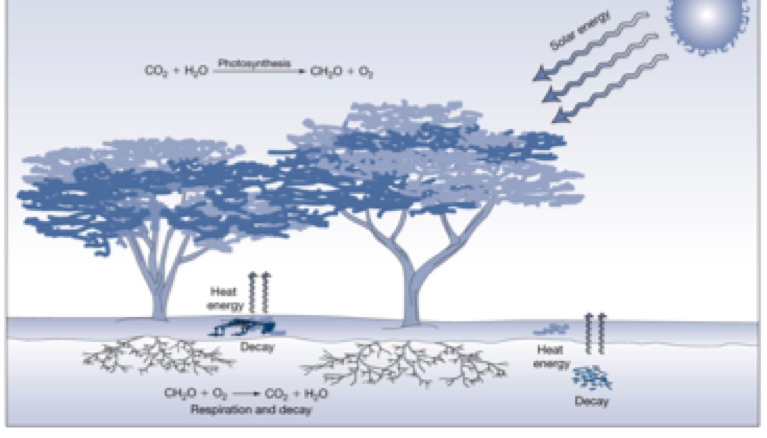"Even if nature does not produce the same species in similar climates, nevertheless vegetation exhibits the most striking visual similarities in habit even in the most distant regions. This phenomenon is one of the most remarkable in the history of organic creations" - Alexander Von Humboldt, 1876
Earth's surface is a key interface in the climate system, providing a lower boundary for the atmosphere, where major exchanges of radiation, heat, momentum, aerosols and greenhouse gases occur. For instance, about 70% of impinging solar radiation is absorbed by the surface, then re-emitted upwards as infrared radiation, else returned to the atmosphere as sensible and latent heat. Any system capable of controlling these surface exchanges will play an important role in determining our planet's climate.

Figure | Land surface processes
Abiotic systems interact with the atmosphere at the Earth's surface via their albedo, their roughness and other physical characteristics (e.g. soil porosity, affecting soil wetness), which are mostly static, unless we include the cryosphere. In the physical exchanges category, oceans, representing about 70% of the surface, are far more important than land, having much larger heat storage capacity and significant horizontal transports. Land, on the other hand, is far more variable and changeable in terms of coupling processes, especially with regards to water. Earth's biosphere comprises terrestrial ecosystems, covering ~50% of the land surface and oceanic ecosystems; plankton occupies very narrow zones of the oceans. Biotic systems can interact with weather and climate in a number of ways, controlling both radiation absorption (via albedo and spectral discrimination), emission (via biomass abundance and distribution) and through heat, moisture and momentum fluxes (via a hierarchy of physiological activities). The long-term history of our planet, documented for instance by fossils, indicates that a dynamic, two-way feedback between live ecosystems and climate has always taken place.
In a recent review Dickinson (2001) argues that “land surface processes are a major element of current comprehensive climate/earth system models”. Further, “From the viewpoint of climate variability, evapotranspiration (ET) is perhaps the most important process that couples land to atmosphere”. A large portion of terrestrial water lost to ET is routed through roots and leaves, in ways that have been historically parametrised by three generations of models (see Sellers’ 1997 review). The latest generation recognises the fundamental fact that water loss from the leaves is a consequence of CO2 assimilation by plants during photosynthesis (Sellers et al. 1996, Dickinson et al. 1998, Cox et al. 2000), linking at the process level the cycles of two gases of major importance for the Earth’s climate: CO2 and H20 and providing the basis for using biomass as a prognostic variable (in practice, dynamic vegetation). Plant photosynthesis is in turn regulated (limited) by leaf nutrients (Farquhar et al., 1980; Collatz et al., 1991), which are linked through multiple cycles with soil nutrients, but until recently prescribed as boundary conditions. Dickinson (2001) and Dickinson et al. (2002) argue that, in order to correctly represent photosynthetic rates (and thus ET) in climate modelling, it is necessary to include the processes responsible for the cycling of nitrogen between leaves and soil. In keeping with the recommendations of the Global Carbon Project (2003), a modern Earth System Model, needs to represent: the physical processes (atmosphere, oceans and terrestrial hydrosphere); the biological and ecophysiological processes (ocean and land); biogeochemical transformations; a range of natural and anthropogenic disturbances to terrestrial ecosystems (e.g. fire, agriculture, clearing); and processes associated with the release of fossil carbon by humans.
Our research in HRCM focusses on the basic land surface and soil physical processes, necessary for enabling the simulation of the additional complexity described above. For this, we use a hierarchy of coupled and off-line land surface models (e.g., JULES, the Joint UK Land Environment Simulator), at local to global scales, by which we can directly select the level of allowed feedback between individual components. As well as studying the importance of complexity, we also target the scaling of the coupling to the atmosphere, using the hierarchy of GCMs that we have created in our research group.